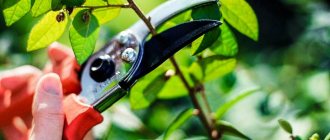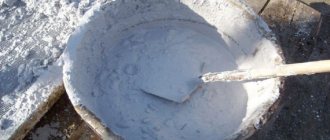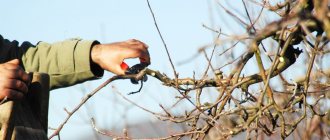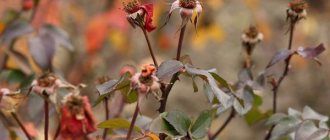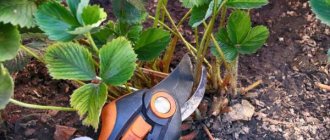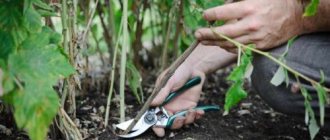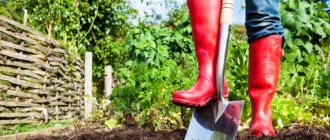Proper pruning of fruit trees is the basis of a beautiful, well-groomed, harvest-rich garden. Features of autumn haircuts, all the “dos” and “don’ts”, “how” and “when”, “why” and “why” - further in the article.
Autumn pruning of fruit trees is a procedure that is as necessary as a haircut for a person. The reasons for it can be completely different.
Some trees have become too overgrown over the summer, their “hair” needs ventilation, so they are thinned out.
Others have suffered from an infestation of pests, and only proper haircutting can help get rid of them completely.
Still others have been exposed to the aggressive effects of the elements, and all dry and broken branches need to be cut out.
The fourth ones have simply grown old, and proper pruning will help them renew themselves and begin bearing fruit with renewed vigor.
Each individual case has its own nuances and its own rules. But if you make a mistake, the tree will suffer and may not even survive until spring. Therefore, autumn haircuts should be approached responsibly and competently.
Attention!
When pruning, tools must be clean and well sharpened.
Timing for pruning trees in autumn
The autumn pruning procedure helps trees to withstand winter cold more easily, and also has a very positive effect on the quality characteristics of the future harvest. But it must be done on time.
Gardening activities begin when nutrients move from the leaves to the trunk and roots, that is, with the fall of the leaves. At this time, sap flow slows down, the tree is preparing to retire, and therefore is least susceptible to injury.
It is best to carry out operations to remove excess growth in September or October. Then the tree will have time to adapt to its new “look” even before the onset of frost and will survive the winter more easily.
In November, it is extremely undesirable to engage in them. After all, if frost hits, the bark in the cut areas will freeze, and the wood underneath will begin to shrink. As a rule, green space injured in this way ultimately dies.
Attention!
Autumn pruning of trees and shrubs is carried out exclusively in regions with a temperate climate. It is extremely undesirable to carry out such procedures in the northern regions: the plants do not have time to recover before the onset of frost.
Working with Large Branches
Tree pruning with a saw is carried out in the following way: first, the branch is sawed from below, then cut off from above. In this case, the cut is smooth and the plant does not suffer. The cut area is cleaned with a knife or emery and coated with varnish to protect it from pests.
Annual branches
When pruning annual shoots, you need to start cutting above a living bud. You need to file diagonally, from the opposite side from the top of the bud to its base. The trimmed stump should remain opposite the bud.
Important! The cut will not heal if the stump is higher than the bud, and if lower, the bud will die.
If there are no buds on the branch, then you need to cut to the first bud located within this distance to the end of the branch. It is unacceptable to cut off more than half of the shoot.
If pruned incorrectly, hollows may appear in the tree. Already in the second year, a fairly large hole may be observed, and in subsequent years, a fracture of the trunk.
A correctly trimmed area will heal within a year.
Shortening old branches
Gardeners prefer to remove old branches completely, but sometimes they also do simple pruning. This is possible if young branches die, do not bear fruit, or grow in the shade.
In this case, the media is carried out over the side or healthiest branch. The cut should be higher than the branch and made diagonally.
Important! Dry old branches, on the contrary, are not cut down to the trunk. The remaining stump may produce new shoots.
Pruning trees and shrubs in autumn, main principles
Attention!
Autumn pruning can only be done on winter-hardy varieties of fruit trees.
Basic principles of pruning
Most often, the gardener's autumn concerns come down to only sanitary pruning of trees. Everything else is postponed until the spring.
But sometimes it is advisable to perform other types of circumcision:
- shortening shoots on first-year plants;
- thinning the crown for better lighting and ventilation;
- its formation according to a predetermined contour;
- rejuvenation of trees.
The procedure is performed in the following order:
- First of all, they carry out sanitary pruning of branches that are diseased, withered, attacked by pests, and also broken due to bad weather or under the weight of the crop.
- Remove all tops and root shoots without exception.
- Next, they get rid of the weakest ones, those growing closely, directed towards the center or vertically upward, as well as branches rubbing against each other.
- In the case of anti-aging pruning, old and unpromising branches are removed.
- Wounds caused during the procedure are carefully treated. For this, garden varnish is most often used.
- All biomaterial obtained as a result of such processing is immediately removed to a considerable distance and must be burned.
Advice!
In the absence of garden varnish, you can use regular oil paint. Moreover, it is even preferable if the cuts are large or there is a high risk of rapid onset of cold weather.
The following figure will help you see in more detail which branches must be removed:
Features of pruning trees of various types and age groups
When pruning young trees, the removal of branches is insignificant. Its main purpose is to form a crown.
The following types are distinguished:
- longline with a central conductor (or leader);
- changed-leader;
- cup-shaped.
A tree that has already entered the fruiting stage needs more severe pruning. At the same time, some branches are cut out completely, while others are only shortened. Such measures allow you to increase the yield, as well as strengthen the structure of the crown so that the branches do not break under its weight.
Old trees need rejuvenating pruning. At the same time, more than half of the old, least productive and unable to provide proper nutrition branches are removed. After carrying out this procedure, the yield decreases slightly in the first year, but then the tree begins to bear fruit with renewed vigor.
Dwarf breeds also need pruning. But they grow much slower than usual. Therefore, you need to cut off much fewer branches from them.
As for shrubs, they wake up very early, so autumn pruning is much preferable to spring pruning for them. This procedure is not only a way to keep them in good condition. This is also an excellent opportunity for rejuvenation, as well as improving the quality characteristics of the crop.
Removing old branches stimulates the growth of young shoots. In addition, this creates conditions for better ventilation and penetration of sunlight. This means that the bush is less susceptible to attacks by various fungi, and the berries on it become sweeter.
Adviсe!
In most cases of fruit tree pruning, removing a few branches each year is much easier to handle than mass pruning of branches every few years.
As a rule, the number of branches cut should be approximately equal to last year's growth (but not more than a third of the crown).
First of all, old, unproductive branches are removed.
Cherry pruning
When to prune
It is better to form the crown of cherries in the spring, but autumn pruning of cherries is carried out not only for sanitary purposes, like other garden trees, but also in order to rejuvenate the tree - these are the recommendations of most experts. However, there are practitioners who believe that pruning cherries in the fall should be done only in emergency cases - in order to remove diseased or injured shoots. Heavy pruning of cherries in the fall slows down their fruiting.
It’s up to you to decide what to do correctly. You can try rejuvenating pruning in the fall, and if you don’t like the results, next time reschedule the pruning until the spring.
In the photo: Ripe cherries on a branch
Autumn pruning
Professionals recommend forming the crown of the cherry tree in the shape of a cone with a wide base - it warms up and is well lit, and air circulates freely between the branches. You can also form the crown in a cup-shape or in tiers. In the fall, after the leaves fall, remove all diseased, dry, broken and disease- or pest-damaged branches and shoots. In order to rejuvenate the crowns, branches six to eight years old are cut into rings, and the sections must be treated with garden varnish or oil paint.
- We retain moisture in the soil - how can we keep snow on the site, how can we direct water during thaws?
Proper planting and care of cherries in the garden
Pruning trees in autumn for beginners in pictures
When starting to trim trees, it is very important to navigate not only how to choose the right tools and time, but also what is the best technology to use to remove excess vegetation. But it is with the last point that novice gardeners most often have problems. The pictures presented here will help you better understand which elements of the tree should be cut first and what is the best way to do it.
branches subject to mandatory removal
Everyone knows that dry and diseased branches are cut out first. Then those that grow inside the crown or interfere with each other. Next, you need to look at the angle between the branch and the trunk.
The closer it is to zero (or 180 degrees, if the branches are directed downwards), the less these branches are predisposed to fruiting.
Therefore, experienced gardeners strive to leave (or form as such) the maximum possible number of branches growing perpendicular to the trunk. After all, it is on them that the largest part of the “fruits” are formed, which are the basis of the future harvest.
Advice!
If the frame branches grow incorrectly, it is not advisable to prune them. It is best to stretch such branches with a rope and secure them. After 2-3 weeks you can release them, or you can leave the tree in this state until spring.
Features of cutting branches
It is important not only to identify the branches needed to remove, but to cut them correctly. The following techniques are used:
Thin branches are cut using pruning shears; for thick ones, a saw is used. It is very important to leave as even cuts as possible on the tree, as well as to use the correct techniques for removing branches. Mistakes here are fraught with a decrease in yield, the development of diseases and even the death of the tree as a whole.
Apricot pruning
When to prune an apricot
Apricots are pruned in spring, summer and autumn, and in the spring the pruning is thorough - formative, sanitary, and, if necessary, rejuvenating. In summer, pruning is done only when there is a danger that the branches may break under the weight of the fruit. The task of autumn sanitary pruning is to prepare the apricot for wintering.
In the photo: Rich harvest of apricots
Apricot pruning in autumn
Before you start pruning, you need to determine what type of crown you want to form on the tree - tiered or non-tiered. If you have limited space, it may make sense to cup the crown, which involves shortening the branches by about half. But no matter what shape of the crown you form, in the fall you must remove all diseased, dry and broken branches, thin out the crown, removing shoots and branches growing inward - sanitary pruning of apricots must be done in the fall. However, it should be taken into account that apricot is a heat-loving crop, so be careful, try not to make deep cuts to it, and if you do injure the tree, treat the wound with copper sulfate and cover it with garden varnish to prevent gum formation.
Proper planting and care of apricots in the garden
How to properly prune an apple tree in the fall, diagram
The apple tree is one of the most popular trees in our latitudes. Not everyone knows this, but it can bear fruit for about a hundred years. But you cannot do without proper care, one of the elements of which is proper pruning.
The scheme for its implementation depends on the age of the apple tree and can be carried out in one of the following ways:
- strong – removal of about 2/3 of the annual growth;
- medium (moderate) – cutting out about half of the growth of the shoot;
- weak - shortening of the shoot by 1/4-1/3 of the annual growth.
Together with them, thinning is also used, that is, cutting out entire shoots.
When formative pruning of young seedlings, light pruning is used with cutting out some shoots entirely. In this case, the central conductor should rise 15-30 cm above the other branches. Skeletal branches are formed from 3-5 lateral shoots, shortened to a bud and leaving their ends at the same level. All competitors are cut into a ring.
During the period of active fruiting (5-10 years), the main task of pruning is to activate the “fruits” and, accordingly, increase the yield. In this case, strong thinning is combined with weak (or medium) shortening. In this way, the density of the crown is regulated, as well as the growth and desired direction of overgrowing branches.
The video will help you better understand all of the above:
Older apple trees need rejuvenation. In this case, severe pruning of apple trees is used: the skeletal branches are cut to the area where the tops appear, and the crown is partially thinned out. The procedure improves the conditions for fruit ripening, which has a better effect on their quality. The branches that need pruning during rejuvenation pruning of old apple trees are perfectly illustrated by the diagram:
How to cover saw cuts on a tree
For many summer residents, the answer is obvious - garden varnish. But in reality, not every var is beneficial to the tree. Scientists from the Institute of Horticulture of the Ukrainian Academy of Agricultural Sciences decided to conduct an experiment: from 2008 to 2011, they used 17 types of garden putties to treat apple trees and came to disappointing conclusions - 70% of them not only do not treat the trees, they cripple them!
Scientists took an untreated saw cut as a standard and compared which varnishes accelerate the healing of the wound, and which, on the contrary, slow it down. So, according to their data, cuts from BlagoSad (51.1% compared to the untreated standard), Lac Balsam Celaflor (20.7%), Malusan Wunderverschluss Neudorff (3.4%), VS-1 (2. 3%) and RanNet (0.2%). The last three brands, although the percentage of overgrowing is higher, is so insignificant that it is not worth spending money on.
And one more thing that few people know: garden pitch can be used to putty wounds whose diameter does not exceed 2 cm. It is not suitable for large cuts. In this case, you need to use oil paint based on drying oil.
How to prune a pear tree in autumn
Like an apple tree, excess growth is also removed from a pear tree, which often naturally forms a well-shaped crown with a central conductor. Usually it is not as dense as that of an apple tree, so it needs similar, but less severe pruning. In addition, since the tree has a tendency to freeze in winter, it is pruned lightly.
But due to the fact that some of the active buds of the pear die, the sleeping ones awaken. And among them, a lot of tops always form, which the gardener must work on. By shortening such shoots are transformed into semi-skeletal and overgrowing branches. All others are removed so as not to interfere.
Attention!
According to experts, it is the autumn pruning of pears that brings the greatest benefit to the tree.
Only pears of early and medium varieties are processed in this way.
In the first year after planting, the seedling is not pruned.
Roses
Roses are prepared for cover in the fall and must be pruned. The procedure protects wintering bushes from freezing and the spread of the main enemy - fungal infections. In grafted varieties, it is also important to remove root shoots.
There are three types of rose pruning:
- weak shortening of the lashes;
- average;
- strong.
The first option, which is better known as “long pruning,” is used for frost-resistant park, climbing and ground cover roses. Their flowers and buds are removed, as well as dead or damaged parts of the stems. The listed species do not like intensive pruning and can respond to it by throwing out long lashes without flowering.
Varietal roses: floribunda, hybrid tea and polyanthus, are shortened by about half the height, leaving from 5 to 8 buds. Medium pruning ensures the appearance of large, beautifully shaped flowers in spring. Unripe and soft shoots are removed; it is advisable to also remove the leaves at the bottom to reduce the risk of rotting.
Heavy pruning weakens the bushes. It is used only in extreme cases - when rapid rejuvenation of hybrid tea roses is needed or they are grown for bouquets. With severe pruning, only 3–4 buds are left. Thus, Old English (peony) roses are regularly pruned, which then grow into a compact bush and bloom profusely.
All debris remaining after pruning - leaves, stems, buds - must be carefully removed from under the rose bushes and burned or sent to a compost pit.
How to prune a plum tree in the fall
Regarding autumn pruning of plums, expert opinions differ. Supporters complain that due to the vagaries of the weather in the spring, you simply may not have time to complete this procedure. Opponents appeal to the fact that mistakes made at this time can become fatal for the tree.
Indeed, autumn cuttings do not last well. The reason for this is a suspension in the growth of cambial cells. Based on the above, it is best to carry out only sanitary pruning of plum trees in the fall. When preparing a tree for winter, it is imperative to remove dry, diseased and broken branches from it, and in some cases also thin out the crown so that it is not injured by a large amount of snow.
For trees in the active fruiting phase, the procedure is carried out according to the following scheme:
How to prune currant bushes in autumn
All types of currants are pruned during the dormant period, when the bushes have neither leaves nor buds.
At the same time, no more than 10 large branches are left on young bushes. On those that have already begun to bear fruit, about a third of the oldest shoots are removed. This is done at the root, near the ground. By the way, in a similar way they get rid of unripe shoots, which, when frozen, significantly reduce the immunity of the plant as a whole. The remaining branches, for better branching, are shortened to the first bud.
Black currant branches bear fruit best at 3-5 years, and white and red ones at 2-5 years. Then they gradually lose productivity. Therefore, all aged branches must be removed. But at the same time, you definitely need to take care of new ones, leaving 3-5 mature replacement shoots every year.
Adviсe!
After removing the shoots from the currant bushes, they need hilling. After all, new branches must sprout from the roots.
Everything that concerns pruning red and white currants can also be applied to gooseberries.
Working with slices
Any cuts heal and tighten more quickly if they have smooth, not torn edges. The edges of the cut should be in the same plane; its edges can be aligned with a file, knife or pruning shears.
Using garden varnish to process the cut
After pruning, trees must be treated: all cut points with a diameter of more than 1 cm must be treated with varnish. You can replace it with paint, but this will increase the healing time of the wound and is only possible for young seedlings.
What's the best way to prune grapes in the fall?
Autumn pruning of grapes is one of the mandatory procedures for this crop. At first glance, the operation is quite complicated, but if it is neglected, the plant will devote all its energy to forming a vine, and then you will simply have to forget about the harvest. Therefore, every beginning winegrower simply needs to master it.
They begin to form a grape bush only after it has completely gotten rid of foliage, but before the onset of persistent cold weather. For good yield and early fruiting, immediately after planting, two main shoots are formed on the grapes.
In the second year of life, in order for the seedling to gain strength, it is shortened by two buds, and in the summer the excess is pinched off. In the third year, removing all unnecessary branches, the fruit link is finally formed: sleeve-knot of replacement-vine of fruiting.
Attention!
The length of pruning vines for each variety is different and depends on its characteristics: short - for 4 buds, medium - for 4-8 and long - for 8-12, and sometimes up to 20 buds (by the way, the first two can be ignored).
When performing the procedure, all cuts left on each of the sleeves must be on one side. Otherwise, circular tissue necrosis may occur, which will lead to the death of the plant.
The formation of a grape bush in the first two years of life is as follows:
In general, starting from the third year, the scheme for autumn pruning of grapes looks something like this:
- All fruit-bearing vines, tops, as well as weak and interfering shoots are cut off.
- All unnecessary branches are removed from young bushes, and annual branches from old ones.
- Fruiting vines are shortened depending on the individual characteristics of the variety. Replacement knots - 3-4 buds.
Adviсe!
Without knowing exactly what variety you are pruning, in order to accurately get into the fruiting zone, it is best to prune by 6-8 buds.
The weaker the shoot, the fewer buds are left on it.
Top shoots are cut out both completely and for replacement knots.
When pruning in autumn, it is advisable to leave 2-3 times more shoots than necessary. This is due to the possibility of them freezing. In the spring, everything unnecessary must be removed.
How to care for a tree after pruning
Next year the trees will need to be well fed and this is done twice per season:
- in April - 0.5 buckets of rotted manure or 1 - 2 kg of chicken manure per 1 sq. m of trunk circle;
- in early June - the same fertilizers in the same doses, and instead of organic matter, you can use mineral fertilizers - ammophosphate or ammonium nitrate (according to the instructions).
In addition to nitrogen, pruned trees in the fall will need phosphorus - it enhances flowering, and potassium, which improves the quality of fruits and increases winter hardiness. Phosphorus fertilizers are applied in the spring, potassium fertilizers in the fall.
And don’t forget the main thing: after you apply fertilizer, the trees need to be watered at the rate of 2 - 3 buckets per 1 square meter. m. And the next day the soil in the tree trunk circle must be properly loosened.
Is it necessary to whiten trees in the fall?
For experienced gardeners, the answer will definitely be positive. And the main reason here is far from aesthetic appeal, which is often used to motivate spring whitewashing. The fact is that this procedure helps the tree to more easily tolerate sudden temperature changes, and, accordingly, to emerge from hibernation with fewer losses.
Otherwise, gardeners have to deal with frost cracks. These wood lesions most often occur at the very end of winter, when the sun is already shining with all its might during the day, and frost returns again at night. Such crevices practically do not heal on their own. They need to be treated long and hard. If this is not done, the tree weakens and eventually dies.
Contrary to popular belief, trees of all age groups without exception need to be whitewashed. But in the case of young seedlings, it is necessary to avoid solutions containing lime or limit its amount in whitewash mixtures as much as possible. Regarding old trees, the painting process becomes much more complicated due to the large amount of pre-painting work.
Advice!
It is advisable to carry out painting work just before frost, so that such a coating lasts as long as possible on the tree trunk.
The trunk and skeletal branches are subject to painting. Moreover, the higher the tree is whitewashed, the better.
High whitewashing of the garden is most conveniently done using a sprayer.
Autumn pruning of dwarf apple trees
Dwarf fruit trees need pruning to establish a balance between the crown and roots, because there must be a biological balance between them. By pruning, you can control the fruiting of this variety.
Before pruning, you should find out what and how developing branches affect. In spring, the apical buds are the first to wake up, giving intensive growth. They are called continuation shoots.
A little lower there may be a point from which a competing escape will appear. It will grow larger than the continuation shoot.
The middle shoots wake up later than everyone else. They are practically useless. If you trim the top ones, then good skeletal branches will grow from these middle ones. Therefore, it is important to determine which of them need to be left in order to form a good crown.
How to whiten trees in the fall
For autumn painting of trees, various mixtures are used: water-based paint, water-dispersion paint, as well as well-known lime solutions. The main requirements for whitewashing compositions are painting the surface white, allowing the skin to “breathe” underneath, and also the duration of stay on the bark.
Modern industry offers a wide range of whitewashes for trees. But you can also cook them yourself. In this case, the composition used for coloring should include the following components:
- white clay, lime or chalk - to give it a white color;
- glue, milk or soap - for better adhesion to the bark;
- fungicide – for disinfection.
Attention!
When using purchased paint, be sure to make sure that it is intended specifically for whitewashing living trees and not for any other wood.
But the whitewashing itself is only the final step in a four-step process. It is preceded by cleaning the trunk, its disinfection, as well as healing of wounds.
